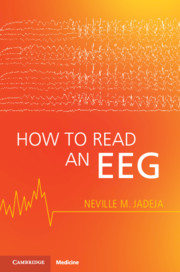Book contents
- How to Read an EEG
- How to Read an EEG
- Copyright page
- Dedication
- Contents
- Figure Contributions
- Foreword
- Preface
- How to Read This Book
- Part I Basics
- Part II Interpretation
- Part III Specific Conditions
- Chapter 18 Common Seizure Mimics
- Chapter 19 Seizures
- Chapter 20 Epilepsies
- Chapter 21 Epilepsy Syndromes
- Chapter 22 Focal Dysfunction (Lesions)
- Chapter 23 Global Dysfunction (Encephalopathy)
- Chapter 24 Status Epilepticus
- Chapter 25 Post Cardiac Arrest
- Chapter 26 Brain Death
- Appendix How to Write a Report
- Index
- References
Chapter 26 - Brain Death
from Part III - Specific Conditions
Published online by Cambridge University Press: 24 June 2021
- How to Read an EEG
- How to Read an EEG
- Copyright page
- Dedication
- Contents
- Figure Contributions
- Foreword
- Preface
- How to Read This Book
- Part I Basics
- Part II Interpretation
- Part III Specific Conditions
- Chapter 18 Common Seizure Mimics
- Chapter 19 Seizures
- Chapter 20 Epilepsies
- Chapter 21 Epilepsy Syndromes
- Chapter 22 Focal Dysfunction (Lesions)
- Chapter 23 Global Dysfunction (Encephalopathy)
- Chapter 24 Status Epilepticus
- Chapter 25 Post Cardiac Arrest
- Chapter 26 Brain Death
- Appendix How to Write a Report
- Index
- References
Summary
The American Academy of Neurology (AAN) recommends EEG as one of the ancillary methods used to confirm cerebral death in combination with a standardized clinical evaluation. The EEG when recorded using the minimal technical standards as outlined by the American Clinical Neurophysiology Society’s (ACNS) guidelines determines electrocerebral inactivity (ECI). Studies have shown that ECI corroborated a clinical determination of brain death in 96.5% of adults, but similar findings have not been reproduced in children. Electrocerebral inactivity (previously called electrocerebral silence) is defined as the absence of any nonartifactual (cerebral) activity over 2 uV (peak to peak) on a scalp EEG recorded using electrode pairs at least 10 cm apart and other technical criteria outlined by the ACNS.
Keywords
Information
- Type
- Chapter
- Information
- How to Read an EEG , pp. 246 - 247Publisher: Cambridge University PressPrint publication year: 2021
